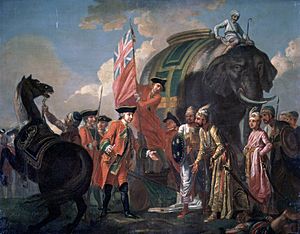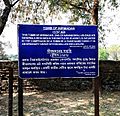Battle of Plassey facts for kids
Quick facts for kids Battle of Plassey |
|||||||||
|---|---|---|---|---|---|---|---|---|---|
| Part of the Seven Years' War | |||||||||
 Lord Clive meeting with Mir Jafar after the Battle of Plassey, oil on canvas (Francis Hayman, c. 1762) |
|||||||||
|
|||||||||
| Belligerents | |||||||||
| Commanders and leaders | |||||||||
|
|
|
||||||||
| Strength | |||||||||
| 750 European soldiers 100 Topasses 2,100 Indian sepoys 100 gunners 8 cannon (six 6-pounders and 2 howitzers) |
35,000 infantry 18,000 cavalry 53 field pieces (mostly 32, 24 and 18-pounders) 50 French artillerymen (6 field pieces) |
||||||||
| Casualties and losses | |||||||||
| 22 killed (5 Europeans, 13 Indians) 50 wounded (15 Europeans and 30 Indians) |
500 killed and wounded | ||||||||
The Battle of Plassey was a very important battle. It happened on June 23, 1757, in a place called Palashi in Bengal, India. This battle was a big win for the British East India Company. They defeated the ruler of Bengal, known as the Nawab, and his French friends.
This battle was part of a bigger war called the Seven Years' War. This was a worldwide conflict where France and its allies fought against Britain and its allies. The British victory at Plassey allowed the British East India Company to start taking control of eastern India. Over the next 100 years, they would control most of the Indian subcontinent.
The battle took place near the Bhagirathi-Hooghly River. This river is a branch of the famous Ganges River. The fighting happened about 150 kilometers (93 miles) north of Calcutta. This area was close to Murshidabad, which was the capital city of Bengal at that time. "Plassey" is just the English way of saying "Palashi." The battle was fought between Siraj ud-Daulah, who was the last independent Nawab of Bengal, and the British East India Company.
Contents
Why the Battle Happened
The Battle of Plassey happened because of growing problems between Siraj ud-Daulah and the British.
British Actions that Angered the Nawab
- Building Forts: The British had made their fort in Calcutta, called Fort William, stronger. They did this without asking the Nawab for permission.
- Trade Rules: The British were also misusing special trade rights given to them by the Mughal rulers. This meant the government was losing a lot of money from customs duties.
- Hiding People: The British also gave shelter to some of the Nawab's officers who had stolen government money. One example was Krishnadas.
Because of these actions, when the East India Company started making Fort William even stronger, Siraj ud-Daulah told them to stop. The Company did not listen. So, Siraj ud-Daulah fought back. In June 1756, he captured Calcutta from the British. He gathered his soldiers and took control of Fort William.
The British Fight Back
The British sent more soldiers to Bengal. These soldiers were led by Colonel Robert Clive and Admiral Charles Watson. They came from Madras (now Chennai).
British Retake Calcutta
The British quickly took back control of Calcutta. After that, Clive captured a French fort called Chandernagar. This was important because the French were allies of the Nawab. The Battle of Plassey happened during the Seven Years' War (1756–1763). The French East India Company sent a small group of soldiers to help the Nawab.
The Plan to Win
Siraj ud-Daulah had many more soldiers than the British. He chose to fight at Plassey. The British were worried because they had fewer soldiers. So, they made a secret plan. They worked with some of Siraj ud-Daulah's unhappy army leaders. These leaders included Mir Jafar, Yar Lutuf Khan, and Rai Durlabh.
Mir Jafar, Rai Durlabh, and Yar Lutuf Khan brought their soldiers close to Plassey. But they did not actually join the battle. This made Siraj ud-Daulah's army much weaker. Colonel Robert Clive's army, with only about 3,000 soldiers, defeated Siraj ud-Daulah's much larger army. Siraj ud-Daulah had to run away from the battlefield.
Results of the Battle
The Battle of Plassey is seen as one of the most important battles in Indian history. It greatly changed who controlled the Indian subcontinent.
British Power Grows
- Influence: The British East India Company now had a lot of power over the Nawab of Bengal.
- Money: They also started getting a lot of money from trade in the region.
- Military Strength: The British used this money to make their military even stronger.
- Pushing Out Rivals: They pushed out other European powers, like the Dutch and the French, from South Asia.
This battle was a clear sign that the British Empire was growing in Asia.
Mir Jafar Becomes Nawab
As a reward for his betrayal, Mir Jafar was made the new Nawab of Bengal. Before this, the previous Nawab, Mutsheed Kiki Khan, had told all landowners in Bengal, Bihar, and Odisha not to sell any land to the British East India Company.
Images for kids
-
The Mughal Empire's Nawab of Bengal Alivardi Khan was strict with European trading companies in Bengal.
-
Robert Clive (1773), by Nathaniel Dance-Holland.
-
9 (Plassey) Battery Royal Artillery of the British military.
See also
 In Spanish: Batalla de Plassey para niños
In Spanish: Batalla de Plassey para niños













